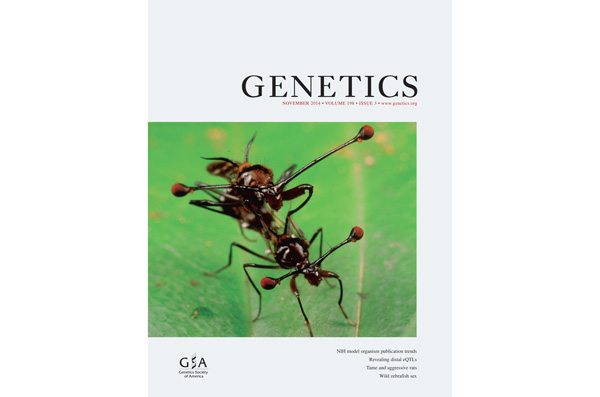The November issue of GENETICS is out today! Check out the highlights below or the full Table of Contents here.
Genetic influences on brain gene expression in rats selected for tameness and aggression, pp. 1277–1290
Henrike O. Heyne, Susann Lautenschläger, Ronald Nelson, François Besnier, Maxime Rotival, Alexander Cagan, Rimma Kozhemyakina, Irina Z. Plyusnina, Lyudmila Trut, Örjan Carlborg, Enrico Petretto, Leonid Kruglyak, Svante Pääbo, Torsten Schöneberg, and Frank W. Albert
For more than 64 generations, two lines of outbred rats have been selected for tameness or aggressiveness, and they now exhibit strikingly different behavior. Heyne et al. investigated the genetic basis of this difference by mapping eQTL affecting brain gene expression using a statistical approach that can identify QTL that have not reached fixation. By comparing the QTL affecting behavior with brain eQTL, the authors identified Gltscr2, Lgi4, Zfp40 andSlc17a7 as candidate genes.
[See the Heyne et al. press release]
Regulation of mitotic spindle disassembly by an environmental stress-sensing pathway in budding yeast, pp. 1043–1057
Adrianne Pigula, David G. Drubin, and Georjana Barnes
Microtuble-associated protein She1 promotes spindle disassembly, the timing of which is essential for coordinating mitotic exit with cytokinesis. Pigula et al. show that in budding yeast the stress-sensing HOG pathway is necessary for She1 localization to the anaphase spindle and for spindle disassembly, even in non-stress conditions.
Plasmid copy number underlies adaptive mutability in bacteria, pp. 919–933
Emiko Sano, Sophie Maisnier-Patin, John Paul Aboubechara, Semarhy Quiñones-Soto, and John R. Roth
In the intensively-studied Cairns system, E. coli cells with a plasmid-borne leaky lac frameshift mutation are plated on lactose where they accumulate Lac+ revertant colonies above the non-growing lawn. Two opposing models explain the origin of these colonies: a) Mutagenesis induced by stress and b) Selection acting on pre-existing partial revertants. Sano et al. present evidence that all revertant colonies arise from pre-existing cells carrying multiple copies of the lac plasmid. They suggest that plasmid over-replication, rather than an increased mutation rate, leads to the observed revertants.
Msh4 and Msh5 function in SC-independent chiasma formation during the streamlined meiosis of Tetrahymena, pp. 983–993
Anura Shodhan, Agnieszka Lukaszewicz, Maria Novatchkova, and Josef Loidl
Crossing over occurs by two distinct pathways in animals, plants and fungi. One is linked to the presence of a synaptonemal complex (SC). Shodhan et al. show that components of this pathway function in the SC-less meiosis of the evolutionarily distant protist Tetrahymena. This simplified meiosis challenges the two-pathway paradigm and may reveal characteristics of the primordial meiotic process.
Hybrid incompatibility arises in a sequence-based bioenergetic model of transcription factor binding, pp. 1155–1166
Alexander Y. Tulchinsky, Norman A. Johnson, Ward B. Watt, and Adam H. Porter
Interspecies hybrids are often inviable or infertile because of incompatibility between interacting genes. To examine how incompatibility evolves at the molecular level, Tulchinsky et al. modeled gene expression as a function of binding energy between a transcription factor and DNA binding site. Under directional selection of gene expression, hybrid incompatibility evolved quickly, either due to non-recognition between transcription factor and binding site across species, or spurious binding. Under stabilizing selection, hybrid incompatibility evolved slowly, through compensatory mutations.
Novel distal eQTL analysis demonstrates effect of population genetic architecture on detecting and interpreting associations, pp. 879–893
Matthew Weiser, Sayan Mukherjee, and Terrence S. Furey
Standard eQTL mapping methods carry significant multiple testing burdens, limiting their ability to detect eQTL distal to the affected gene. Weiser et al. describe a novel eQTL testing approach based on the pairwise conditional dependencies between genes’ expression levels. They apply the method to data from yeast, mouse, and human, and identify thousands of novel eQTL. Genes implicated as distal eQTL were enriched for metabolism and biosynthesis annotations, suggesting they participate in feedback mechanisms.
Wild sex in zebrafish: loss of the natural sex determinant in domesticated strains, pp.1291–1308
Catherine A. Wilson, Samantha K. High, Braedan M. McCluskey, Angel Amores, Yi-lin Yan, Tom A. Titus, Jennifer L. Anderson, Peter Batzel, Michael J. Carvan, Manfred Schartl, and John H. Postlethwait
Laboratory stocks of zebrafish have fluctuating sex ratios, but the sex determination mechanism in this important genetic model is unknown. Wilson et al. show that natural zebrafish populations have a single sex determining locus and a female-ZW/male-ZZ sex chromosome system. Unexpectedly, domesticated stocks lacked detectable sex-linked loci. These results suggest that key components of the sex determination system were lost during domestication, and variant mechanisms may have evolved or been unmasked over two decades of laboratory culture.
PERSPECTIVE
Publication trends in model organism research, pp. 787–794
Michael R. Dietrich, Rachel A. Ankeny, and Patrick M. Chen
In 1990, the National Institutes of Health (NIH) gave some organisms special status as designated model organisms. This article documents publication trends for these NIH-designated model organisms over the past 40 years. The authors find that being designated a model organism by the NIH does not guarantee an increasing publication trend. An analysis of model and non-model organisms included in GENETICS since 1960 does reveal a sharp decline in the number of publications using non-model organisms yet no decline in the overall species diversity. They suggest that organisms with successful publication records tend to share critical characteristics, such as being well-developed as standardized, experimental systems and being used by well-organized communities with good networks of exchange and methods of communication.













